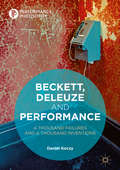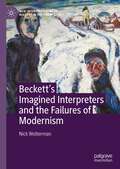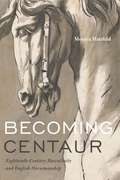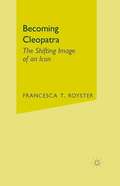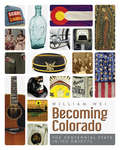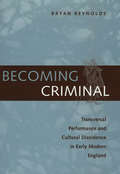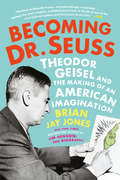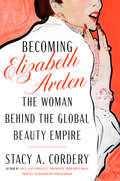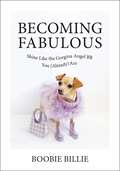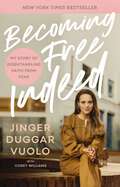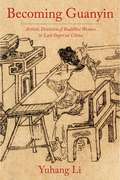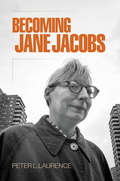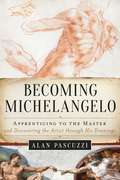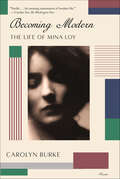- Table View
- List View
Beckett's Intuitive Spectator: Me to Play (New Interpretations of Beckett in the Twenty-First Century)
by Michelle ChiangBeckett’s Intuitive Spectator: Me to Play investigates how audience discomfort, instead of a side effect of a Beckett pedagogy, is a key spectatorial experience which arises from an everyman intuition of loss. With reference to selected works by Henri Bergson, Immanuel Kant and Gilles Deleuze, this book charts the processes of how an audience member’s habitual way of understanding could be frustrated by Beckett’s film, radio, stage and television plays. Michelle Chiang explores the ways in which Beckett exploited these mediums to reconstitute an audience response derived from intuition.
Beckett, Deleuze and Performance: A Thousand Failures and A Thousand Inventions (Performance Philosophy)
by Daniel KoczyThis book draws on the theatrical thinking of Samuel Beckett and the philosophy of Gilles Deleuze to propose a method for research undertaken at the borders of performance and philosophy. Exploring how Beckett fabricates encounters with the impossible and the unthinkable in performance, it asks how philosophy can approach what cannot be thought while honouring and preserving its alterity. Employing its method, it creates a series of encounters between aspects of Beckett’s theatrical practice and a range of concepts drawn from Deleuze’s philosophy. Through the force of these encounters, a new range of concepts is invented. These provide novel ways of thinking affect and the body in performance; the possibility of theatrical automation; and the importance of failure and invention in our attempts to respond to performance encounters. Further, this book includes new approaches to Beckett’s later theatrical work and provides an overview of Deleuze’s conception of philosophical practice as an ongoing struggle to think with immanence.
Beckett’s Imagined Interpreters and the Failures of Modernism (New Interpretations of Beckett in the Twenty-First Century)
by Nick WoltermanSamuel Beckett’s work is littered with ironic self-reflexive comments on presumed audience expectations that it should ultimately make explicable sense. An ample store of letters and anecdotes suggests Beckett’s own preoccupation with and resistance to similar interpretive mindsets. Yet until now such concerns have remained the stuff of scholarly footnotes and asides. Beckett’s Imagined Interpreters and the Failures of Modernism addresses these issues head-on and investigates how Beckett’s ideas about who he writes for affect what he writes. What it finds speaks to current understandings not only of Beckett’s techniques and ambitions, but also of modernism’s experiments as fundamentally compromised challenges to enshrined ways of understanding and organizing the social world. Beckett’s uniquely anxious audience-targeting brings out similarly self-doubting strategies in the work of other experimental twentieth-century writers and artists in whom he is interested: his corpus proves emblematic of a modernism that understands its inability to achieve transformative social effects all at once, but that nevertheless judiciously complicates too-neat distinctions drawn within ongoing culture wars. For its re-evaluations of four key points of orientation for understanding Beckett’s artistic ambitions—his arch critical pronouncements, his postwar conflations of value and valuelessness, his often-ambiguous self-commentary, and his sardonic metatheatrical play—as well as for its running dialogue with wider debates around modernism as a social phenomenon, this book is of interest to students and researchers interested in Beckett, modernism, and the relations between modern and contemporary artistic and social developments.
Becky Chan: A Novel
by Jared MitchellBecky Chan’s life gets off to a rocky start. She is born into a poor family, with a ne’er-do-well father. But by 1967, she is the reigning queen of the Hong Kong film industry, and her life is frequently confused by her public with the roles that she plays, including the Goddess of Mercy. In the city, Communist factions are setting bombs and kidnapping people. In mainland China, itself in the throes of the Cultural Revolution, rival factions of the Communist Party are terrorizing the nation. In the midst of this turmoil, Becky Chan disappears.Told from the point of view of an aging Canadian expatriate residing in the colony, Becky Chan is an absorbing and intriguing story that is entirely set in the Hong Kong film world. Woven into Becky’s life story, itself the stuff of a Mandarin movie, are the plots of several of her 190 films.
Become a Chess Champion: Learn the Basics from a Pro
by Neon Squid James Canty IIIKids will learn how to master the basics of the classic board game in this fun beginner’s guide from professional chess player James Canty III.Become a Chess Champion is structured like a chess course, with knowledge carefully introduced as readers turn the pages – assisted by hilarious chess pieces illustrated by Brian Lambert. The emphasis is on fun: James Canty III uses mini games and chess puzzles to teach important concepts and avoid overwhelming beginners. Kids will learn key skills like how to play the perfect opening and trick their opponents to bring about checkmate. By the end of the book readers should be able to confidently take on their parents, guardians or grandparents in a competitive game of chess!Become a Chess Champion also introduces kids to the wonderful world of chess. They’ll meet the chess player who didn’t lose a game for 30 years, the priest who invented the folding chess board, and the astronauts on the International Space station who had a chess match with people back on Earth!As well as being great fun, chess also helps kids develop key skills such as strategising, patience, and logic, and helps them excel in school subjects such as mathematics.The cover features gold foil, making this book the perfect gift. Check it out!
Becoming Audible: Sounding Animality in Performance (Animalibus)
by Austin McQuinnBecoming Audible explores the phenomenon of human and animal acoustic entanglements in art and performance practices. Focusing on the work of artists who get into the spaces between species, Austin McQuinn discovers that sounding animality secures a vital connection to the creatural.To frame his analysis, McQuinn employs Gilles Deleuze and Félix Guattari’s concept of becoming-animal, Donna Haraway’s definitions of multispecies becoming-with, and Mladen Dolar’s ideas of voice-as-object. McQuinn considers birdsong in the work of Beatrice Harrison, Olivier Messiaen, Céleste Boursier-Mougenot, Daniela Cattivelli, and Marcus Coates; the voice of the canine as a sacrificial lab animal in the operatic work of Alexander Raskatov; hierarchies of vocalization in human-simian cultural coevolution in theatrical adaptations of Franz Kafka and Eugene O’Neill; and the acoustic exchanges among hybrid human-animal creations in Harrison Birtwistle’s opera The Minotaur. Inspired by the operatic voice and drawing from work in art and performance studies, animal studies, zooarchaeology, social and cultural anthropology, and philosophy, McQuinn demonstrates that sounding animality in performance resonates “through the labyrinths of the cultural and the creatural,” not only across species but also beyond the limits of the human.Timely and provocative, this volume outlines new methods of unsettling human exceptionalism during a period of urgent reevaluation of interspecies relations. Students and scholars of human-animal studies, performance studies, and art historians working at the nexus of human and animal will find McQuinn’s book enlightening and edifying.
Becoming Audible: Sounding Animality in Performance (Animalibus: Of Animals and Cultures #18)
by Austin McQuinnBecoming Audible explores the phenomenon of human and animal acoustic entanglements in art and performance practices. Focusing on the work of artists who get into the spaces between species, Austin McQuinn discovers that sounding animality secures a vital connection to the creatural.To frame his analysis, McQuinn employs Gilles Deleuze and Félix Guattari’s concept of becoming-animal, Donna Haraway’s definitions of multispecies becoming-with, and Mladen Dolar’s ideas of voice-as-object. McQuinn considers birdsong in the work of Beatrice Harrison, Olivier Messiaen, Céleste Boursier-Mougenot, Daniela Cattivelli, and Marcus Coates; the voice of the canine as a sacrificial lab animal in the operatic work of Alexander Raskatov; hierarchies of vocalization in human-simian cultural coevolution in theatrical adaptations of Franz Kafka and Eugene O’Neill; and the acoustic exchanges among hybrid human-animal creations in Harrison Birtwistle’s opera The Minotaur. Inspired by the operatic voice and drawing from work in art and performance studies, animal studies, zooarchaeology, social and cultural anthropology, and philosophy, McQuinn demonstrates that sounding animality in performance resonates "through the labyrinths of the cultural and the creatural," not only across species but also beyond the limits of the human.Timely and provocative, this volume outlines new methods of unsettling human exceptionalism during a period of urgent reevaluation of interspecies relations. Students and scholars of human-animal studies, performance studies, and art historians working at the nexus of human and animal will find McQuinn’s book enlightening and edifying.
Becoming Beatriz
by Tami CharlesBeatriz dreams of a life spent dancing--until tragedy on the day of her quinceañera changes everything.Up until her fifteenth birthday, the most important thing in the world to Beatriz Mendez was her dream of becoming a professional dancer and getting herself and her family far from the gang life that defined their days--that and meeting her dance idol Debbie Allen on the set of her favorite TV show, Fame. But after the latest battle in a constant turf war leaves her brother, Junito, dead and her mother grieving, Beatriz has a new set of priorities. How is she supposed to feel the rhythm when her brother's gang needs running, when her mami can't brush her own teeth, and when the last thing she can remember of her old self is dancing with her brother, followed by running and gunshots? When the class brainiac reminds Beatriz of her love of the dance floor, her banished dreams sneak back in. Now the only question is: will the gang let her go? Set in New Jersey in 1984, Beatriz's story is a timeless one of a teenager's navigation of romance, her brother's choices, and her own family's difficult past. A companion novel to the much-lauded Like Vanessa.
Becoming Beautiful: Ballroom Dance in the American Heartland
by Joanna BosseIn Becoming Beautiful, Joanna Bosse explores the transformations undergone by the residents of a Midwestern town when they step out on the dance floor for the very first time. Bosse uses sensitive fieldwork as well as her own immersion in ballroom culture to lead readers into a community that springs up around ballroom dance. The result is a portrait of the real people who connect with others, change themselves, and join a world that foxtrots to its own rules, conventions, and rewards. Bosse's eye for revealing, humorous detail adds warmth and depth to discussions around critical perspectives on the experiences the dance hall provides, the nature of partnership and connection, and the notion of how dancing allows anyone to become beautiful.
Becoming Centaur: Eighteenth-Century Masculinity and English Horsemanship (Animalibus)
by Monica MattfeldIn this study of the relationship between men and their horses in seventeenth- and eighteenth-century England, Monica Mattfeld explores the experience of horsemanship and how it defined one’s gendered and political positions within society.Men of the period used horses to transform themselves, via the image of the centaur, into something other—something powerful, awe-inspiring, and mythical. Focusing on the manuals, memoirs, satires, images, and ephemera produced by some of the period’s most influential equestrians, Mattfeld examines how the concepts and practices of horse husbandry evolved in relation to social, cultural, and political life. She looks closely at the role of horses in the world of Thomas Hobbes and William Cavendish; the changes in human social behavior and horse handling ushered in by elite riding houses such as Angelo’s Academy and Mr. Carter’s; and the public perception of equestrian endeavors, from performances at places such as Astley’s Amphitheatre to the satire of Henry William Bunbury. Throughout, Mattfeld shows how horses aided the performance of idealized masculinity among communities of riders, in turn influencing how men were perceived in regard to status, reputation, and gender.Drawing on human-animal studies, gender studies, and historical studies, Becoming Centaur offers a new account of masculinity that reaches beyond anthropocentrism to consider the role of animals in shaping man.
Becoming Centaur: Eighteenth-Century Masculinity and English Horsemanship (Animalibus: Of Animals and Cultures #9)
by Monica MattfeldIn this study of the relationship between men and their horses in seventeenth- and eighteenth-century England, Monica Mattfeld explores the experience of horsemanship and how it defined one’s gendered and political positions within society.Men of the period used horses to transform themselves, via the image of the centaur, into something other—something powerful, awe-inspiring, and mythical. Focusing on the manuals, memoirs, satires, images, and ephemera produced by some of the period’s most influential equestrians, Mattfeld examines how the concepts and practices of horse husbandry evolved in relation to social, cultural, and political life. She looks closely at the role of horses in the world of Thomas Hobbes and William Cavendish; the changes in human social behavior and horse handling ushered in by elite riding houses such as Angelo’s Academy and Mr. Carter’s; and the public perception of equestrian endeavors, from performances at places such as Astley’s Amphitheatre to the satire of Henry William Bunbury. Throughout, Mattfeld shows how horses aided the performance of idealized masculinity among communities of riders, in turn influencing how men were perceived in regard to status, reputation, and gender.Drawing on human-animal studies, gender studies, and historical studies, Becoming Centaur offers a new account of masculinity that reaches beyond anthropocentrism to consider the role of animals in shaping man.
Becoming Clara Schumann: Performance Strategies and Aesthetics in the Culture of the Musical Canon
by Alexander StefaniakWell before she married Robert Schumann, Clara Schumann was already an internationally renowned pianist, and she concertized extensively for several decades after her husband's death. Despite being tied professionally to Robert, Clara forged her own career and played an important role in forming what we now recognize as the culture of classical music.Becoming Clara Schumann guides readers through her entire career, including performance, composition, edits to her husband's music, and teaching. Alexander Stefaniak brings together the full run of Schumann's concert programs, detailed accounts of her performances and reception, and other previously unexplored primary source material to illuminate how she positioned herself within larger currents in concert life and musical aesthetics. He reveals that she was an accomplished strategist, having played roughly 1,300 concerts across western and central Europe over the course of her six-decade career, and she shaped the canonization of her husband's music. Extraordinary for her time, Schumann earned success and prestige by crafting her own playing style, selecting and composing her own concerts, and acting as her own manager.By highlighting Schumann's navigation of her musical culture's gendered boundaries, Becoming Clara Schumann details how she cultivated her public image in order to win over audiences and embody some of her field's most ambitious aspirations for musical performance.
Becoming Cleopatra: The Shifting Image of an Icon
by Francesca T. RoysterCleopatra is one of our icons of “exotic” femininity. Sexy, political, and racially ambiguous--since the time of Shakespeare she has been a central character in popular culture. And, more often than not, Cleopatra has been imagined as the epitome of dangerous female sexuality. Moving fluidly from Shakespeare's England to contemporary Los Angeles, Francesca Royster looks at the performance of race and sexuality in a wide range of portrayals of Cleopatra. Royster begins with Shakespeare's original appropriation of Plutarch, and then moves on to analyze performances of the Cleopatra icon by Josephine Baker, and the on screen performances of Elizabeth Taylor, Tamara Dobson (Cleopatra Jones), and Queen Latifah (in Set It Off).
Becoming Colorado: The Centennial State in 100 Objects
by William WeiCopublished with History Colorado In Becoming Colorado, historian William Wei paints a vivid portrait of Colorado history using 100 of the most compelling artifacts from Colorado’s history. These objects reveal how Colorado has evolved over time, allowing readers to draw multiple connections among periods, places, and people. Collectively, the essays offer a treasure trove of historical insight and unforgettable detail. Beginning with Indigenous people and ending in the early years of the twenty-first century, Wei traces Colorado’s story by taking a close look at unique artifacts that bring to life the cultures and experiences of its people. For each object, a short essay accompanies a full-color photograph. These accessible accounts tell the human stories behind the artifacts, illuminating each object’s importance to the people who used it and its role in forming Colorado’s culture. Together, they show how Colorado was shaped and how Coloradans became the people they are. Theirs is a story of survival, perseverance, enterprise, and luck. Providing a fresh lens through which to view Colorado’s past, Becoming Colorado tells an inclusive story of the Indigenous and the immigrant, the famous and the unknown, the vocal and the voiceless—for they are all Coloradans.
Becoming Criminal: Transversal Performance and Cultural Dissidence in Early Modern England
by Bryan ReynoldsIn this book Bryan Reynolds argues that early modern England experienced a sociocultural phenomenon, unprecedented in English history, which has been largely overlooked by historians and critics. Beginning in the 1520s, a distinct "criminal culture" of beggars, vagabonds, confidence tricksters, prostitutes, and gypsies emerged and flourished. This community defined itself through its criminal conduct and dissident thought and was, in turn,officially defined by and against the dominant conceptions of English cultural normality.Examining plays, popular pamphlets, laws, poems, and scholarly work from the period, Reynolds demonstrates that this criminal culture, though diverse, was united by its own ideology, language, and aesthetic. Using his transversal theory, he shows how the enduring presence of this criminal culture markedly influenced the mainstream culture's aesthetic sensibilities, socioeconomic organization, and systems of belief. He maps the effects of the public theater's transformative force of transversality, such as through the criminality represented by Shakespeare, Jonson, Middleton, and Dekker, on both Elizabethan and Jacobean society and the scholarship devoted to it.
Becoming Dr. Seuss: Theodor Geisel and the Making of an American Imagination
by Brian Jay JonesThe definitive, fascinating, all-reaching biography of Dr. Seuss Dr. Seuss is a classic American icon. Whimsical and wonderful, his work has defined our childhoods and the childhoods of our own children. The silly, simple rhymes are a bottomless well of magic, his illustrations timeless favorites because, quite simply, he makes us laugh. The Grinch, the Cat in the Hat, Horton, and so many more, are his troupe of beloved, and uniquely Seussian, creations. Theodor Geisel, however, had a second, more radical side. It is there that the allure and fasciation of his Dr. Seuss alter ego begins. He had a successful career as an advertising man and then as a political cartoonist, his personal convictions appearing, not always subtly, throughout his books—remember the environmentalist of The Lorax? Geisel was a complicated man on an important mission. He introduced generations to the wonders of reading while teaching young people about empathy and how to treat others well. Agonizing over word choices and rhymes, touching up drawings sometimes for years, he upheld a rigorous standard of perfection for his work. Geisel took his responsibility as a writer for children seriously, talking down to no reader, no matter how small. And with classics like Green Eggs and Ham, and One Fish, Two Fish, Red Fish, Blue Fish, Geisel delighted them while they learned. Suddenly, reading became fun. Coming right of the heels off George Lucas and bestselling Jim Henson, Brian Jay Jones is quickly developing a reputation as a master biographer of the creative geniuses of our time.
Becoming Elizabeth Arden: The Woman Behind the Global Beauty Empire
by Stacy A. CorderyA sweeping biography of one of the most influential and successful business-women in American history, BECOMING ELIZABETH ARDEN opens the Red Door to a world of wealth, glamor, and the profitable business of beautyElizabeth Arden was a household name on six continents and a millionaire several times over before her death in 1966. Arden counted British royalty and social elites from the overlapping worlds of New York, Hollywood, London, and Paris among her clients. She revolutionized skin care and cosmetics, making it acceptable for all women to embrace glamour and wear makeup—not just actresses and prostitutes. She created a successful international business empire before women gained the vote and at a time when virtually no woman owned or ran a national company. She developed the first luxury spa and insisted on a holistic understanding of health and beauty. Unconventional and driven, Arden fervently believed that every woman could be beautiful.Acclaimed biographer Stacy Cordery does full justice to one of America&’s greatest entrepreneurs. Canadian-born Florence Nightingale Graham turned herself into Elizabeth Arden, using her uncanny sense of the possible to take full advantage of everything New York City offered, building her company and becoming one with her brand. In an astounding rags-to-riches tale, Elizabeth Arden came to personify sophistication and refinement. Her hard work and innovation made makeup, fitness, and style not only acceptable but de rigueur. Arden prospered throughout the Depression, reimagined women&’s needs during two World Wars, and by pioneering new approaches to marketing and advertising, ushered beauty into the modern era. Cordery delivers a compelling picture of a modern CEO whose career provides a model for aspiring businesses to this day.
Becoming Fabulous: Shine Like the Gorgina Angel BB You (Already) Are
by Boobie BillieInstagram&’s chicest Chihuahua mix Boobie Billie teaches you how to be the most fabulous version of yourself as she shares her journey from intern to fashion icon.When Boobie Billie launched her Instagram account in December 2019, she was just a 6.5-pound Italian Greyhuahua standing in front of the world asking it to wear more color. Since then, she has fostered a community of hundreds of thousands of followers, been featured in every style publication worth tweeting about, and brought joy to a world that could use a few more mini-handbags. So what&’s next for this star? Sharing the secrets to having a fabulous glow-up just like her, duh! In her book debut, the internet's favorite four-legged fashion influencer invites you to: Wear clothes as colorful as you are.Take care of yourself (because if you don't, who will?)Prioritize time with your very best friends (or bbs, as Boobie likes to say)Love yourself firstFeaturing exclusive new photos of Boobie Billie, Becoming Fabulous will give you everything you need to become your own gorgina angel bb. (Spoiler alert: it's in you already.) So grab your coziest blanket, put on your fav rejuvenating mask, and blast your Feel Good playlist. It's going to be a stunning ride.
Becoming Free Indeed: My Story of Disentangling Faith from Fear
by Jinger VuoloJinger Vuolo, the sixth child in the famous Duggar family of TLC's 19 Kids and Counting and Counting On, recounts how she began to question the unhealthy ideology of her youth and learned to embrace true freedom in Christ.When Jinger Duggar Vuolo was growing up, she was convinced that obeying the rules was the key to success and God's favor. She zealously promoted the Basic Life Principles of Bill Gothard,fastidiously obeying the modesty guidelines (no shorts or jeans, only dresses),eagerly submitting to the umbrella of authority (any disobedience of parents would place her outside God's protection), promoting the relationship standard of courtship, andavoiding any music with a worldly beat, among others. Jinger, along with three of her sisters, wrote a New York Times bestseller about their religious convictions. She believed this level of commitment would guarantee God's blessing, even though in private she felt constant fear that she wasn't measuring up to the high standards demanded of her.In Becoming Free Indeed, Jinger shares how in her early twenties, a new family member—a brother-in-law who didn't grow up in the same tight-knit conservative circle as Jinger—caused her to examine her beliefs. He was committed to the Bible, but he didn't believe many of the things Jinger had always assumed were true. His influence, along with the help of a pastor named Jeremy Vuolo, caused Jinger to see that her life was built on rules, not God's Word.Jinger committed to studying the Bible—truly understanding it—for the first time. What resulted was an earth-shaking realization: much of what she'd always believed about God, obedience to His Word, and personal holiness wasn't in-line with what the Bible teaches.Now with a renewed faith of personal conviction, Becoming Free Indeed shares what it was like living under the tenants of Bill Gothard, the Biblical truth that changed her perspective, and how she disentangled her faith with her belief in Jesus intact.
Becoming Guanyin: Artistic Devotion of Buddhist Women in Late Imperial China (Premodern East Asia: New Horizons)
by Yuhang LiThe goddess Guanyin began in India as the bodhisattva Avalokiteśvara, originally a male deity. He gradually became indigenized as a female deity in China over the span of nearly a millennium. By the Ming (1358–1644) and Qing (1644–1911) periods, Guanyin had become the most popular female deity in China. In Becoming Guanyin, Yuhang Li examines how lay Buddhist women in late imperial China forged a connection with the subject of their devotion, arguing that women used their own bodies to echo that of Guanyin.Li focuses on the power of material things to enable women to access religious experience and transcendence. In particular, she examines how secular Buddhist women expressed mimetic devotion and pursued religious salvation through creative depictions of Guanyin in different media such as painting and embroidery and through bodily portrayals of the deity using jewelry and dance. These material displays expressed a worldview that differed from yet fit within the Confucian patriarchal system. Attending to the fabrication and use of “women’s things” by secular women, Li offers new insight into the relationships between worshipped and worshipper in Buddhist practice. Combining empirical research with theoretical insights from both art history and Buddhist studies, Becoming Guanyin is a field-changing analysis that reveals the interplay between material culture, religion, and their gendered transformations.
Becoming Jane Jacobs
by Peter L. LaurenceJane Jacobs is universally recognized as one of the key figures in American urbanism. The author of The Death and Life of Great American Cities, she uncovered the complex and intertwined physical and social fabric of the city and excoriated the urban renewal policies of the 1950s. As the legend goes, Jacobs, a housewife, single-handedly stood up to Robert Moses, New York City's powerful master builder, and other city planners who sought first to level her Greenwich Village neighborhood and then to drive a highway through it. Jacobs's most effective weapons in these David-versus-Goliath battles, and in writing her book, were her powers of observation and common sense.What is missing from such discussions and other myths about Jacobs, according to Peter L. Laurence, is a critical examination of how she arrived at her ideas about city life. Laurence shows that although Jacobs had only a high school diploma, she was nevertheless immersed in an elite intellectual community of architects and urbanists. Becoming Jane Jacobs is an intellectual biography that chronicles Jacobs's development, influences, and writing career, and provides a new foundation for understanding Death and Life and her subsequent books. Laurence explains how Jacobs's ideas developed over many decades and how she was influenced by members of the traditions she was critiquing, including Architectural Forum editor Douglas Haskell, shopping mall designer Victor Gruen, housing advocate Catherine Bauer, architect Louis Kahn, Philadelphia city planner Edmund Bacon, urban historian Lewis Mumford, and the British writers at The Architectural Review. Rather than discount the power of Jacobs's critique or contributions, Laurence asserts that Death and Life was not the spontaneous epiphany of an amateur activist but the product of a professional writer and experienced architectural critic with deep knowledge about the renewal and dynamics of American cities.
Becoming Leonardo: An Exploded View Of The Life Of Leonardo Da Vinci
by Mike LankfordWhy did Leonardo Da Vinci leave so many of his major works uncompleted? Why did this resolute pacifist build war machines for the notorious Borgias? Why did he carry the Mona Lisa with him everywhere he went for decades, yet never quite finish it? Why did he write backwards, and was he really at war with Michelangelo? And was he gay? In a book unlike anything ever written about the Renaissance genius, Mike Lankford explodes every cliché about Da Vinci and then reconstructs him based on a rich trove of available evidence—bringing to life for the modern reader the man who has been studied by scholars for centuries, yet has remained as mysterious as ever. Seeking to envision Da Vinci without the obscuring residue of historical varnish, the sights, sounds, smells, and feel of Renaissance Italy—usually missing in other biographies—are all here, transporting readers back to a world of war and plague and court intrigue, of viciously competitive famous artists, of murderous tyrants with exquisite tastes in art …. Lankford brilliantly captures Da Vinci's life as the compelling and dangerous adventure it seems to have actually been—fleeing from one sanctuary to the next, somehow surviving in war zones beside his friend Machiavelli, struggling to make art his way or no way at all ... and often paying dearly for those decisions. It is a thrilling and absorbing journey into the life of a ferociously dedicated loner, whose artwork in one way or another represents his noble rebellion, providing inspiration that is timeless.From the Hardcover edition.
Becoming Michelangelo: Apprenticing to the Master, and Discovering the Artist through His Drawings
by Alan PascuzziMichelangelo’s developing genius is revealed as never before by the man who became Michelangelo’s last apprentice— an American artist and art historian whose family helped carve Mount Rushmore. Many believe Michelangelo's talent was miraculous and untrained, the product of “divine” genius—a myth that Michelangelo himself promoted by way of cementing his legacy. But the young Michelangelo studied his craft like any Renaissance apprentice, learning from a master, copying, and experimenting with materials and styles. In this extraordinary book, Alan Pascuzzi recounts the young Michelangelo’s journey from student to master, using the artist’s drawings to chart his progress and offering unique insight into the true nature of his mastery. Pascuzzi himself is today a practicing artist in Florence, Michelangelo’s city. When he was a grad student in art history, he won a Fulbright to “apprentice” himself to Michelangelo: to study his extant drawings and copy them to discern his progression in technique, composition, and mastery of anatomy. Pascuzzi also relied on the Renaissance treatise that “Il Divino” himself would have been familiar with, Cennino Cennini's The Craftsman’s Handbook (1399), which was available to apprentices as a kind of textbook of the period. Pascuzzi’s narrative traces Michelangelo’s development as an artist during the period from roughly 1485, the start of his apprenticeship, to his completion of the Sistine Chapel ceiling in 1512. Analyzing Michelangelo’s burgeoning abilities through copies he himself executed in museums and galleries in Florence and elsewhere, Pascuzzi unlocks the transformation that made him great. At the same time, he narrates his own transformation from student to artist as Michelangelo’s last apprentice.
Becoming Modern: The Life of Mina Loy
by Carolyn BurkeThe poet and visual artist Mina Loy has long had an underground reputation as an exemplary avant-gardist. Born in London of mixed Jewish and English parentage, and a much photographed beauty, she moved in the pivotal circles of international modernism—in Florence as Gertrude Stein's friend and Marinetti's lover; in New York as Marcel Duchamp's co-conspirator and Djuna Barnes's confidante; in Mexico with the greatest love, the notorious boxer-poet Arthur Cravan; in Paris with the Surrealists and Man Ray. Carolyn Burke's riveting, authoritative biography, Becoming Modern, brings this highly original and representative figure wonderfully alive, in the process giving us a new picture of modernism—and one woman's important contribution to it.
Becoming Palestine: Toward an Archival Imagination of the Future
by Gil Z. HochbergIn Becoming Palestine, Gil Z. Hochberg examines how contemporary Palestinian artists, filmmakers, dancers, and activists use the archive in order to radically imagine Palestine's future. She shows how artists such as Jumana Manna, Kamal Aljafari, Larissa Sansour, Farah Saleh, Basel Abbas, and Ruanne Abou-Rahme reimagine the archive, approaching it not through the desire to unearth hidden knowledge, but to sever the identification of the archive with the past. In their use of archaeology, musical traditions, and archival film and cinematic footage, these artists imagine a Palestinian future unbounded from colonial space and time. By urging readers to think about archives as a break from history rather than as history's repository, Hochberg presents a fundamental reconceptualization of the archive's liberatory potential.

